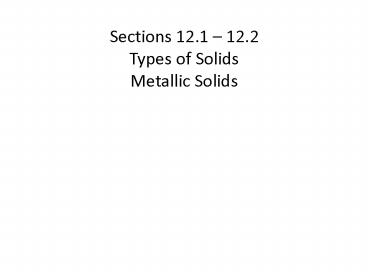Sections 12.1 - PowerPoint PPT Presentation
Title:
Sections 12.1
Description:
Sections 12.1 12.2 Types of Solids Metallic Solids * * * * Types of Solids and Metallic Solids In these sections Types of Solids Unit Cells Cubic Unit Cells X ... – PowerPoint PPT presentation
Number of Views:55
Avg rating:3.0/5.0
Title: Sections 12.1
1
Sections 12.1 12.2 Types of SolidsMetallic
Solids
2
Types of Solids and Metallic Solids
- In these sections
- Types of Solids
- Unit Cells
- Cubic Unit Cells
- X-Ray Diffraction
3
Types of Solids Ionic Molecular Network
crystalline amorphous Metallic
Metallic Close-packed
4
(No Transcript)
5
More Network Solids
diamond
Quartz SiO2
6
(No Transcript)
7
(No Transcript)
8
(No Transcript)
9
Counting Atoms in Unit Cells Inside
1 Face ½ Edge ¼ Corner 1/8
10
(No Transcript)
11
(No Transcript)
12
Unit Cells, Dimensions and Measurements What
percentage of a simple cubic unit cell is filled
with atoms?
13
Unit Cells, Dimensions and Measurements Ca
metal Face centered cubic unit cell Density
1.54 g/cm3 What is the radius of a Ca atom?
14
Unit Cells, Dimensions and Measurements U
metal Body centered cubic unit cell Unit cell
edge 343 pm What is the radius of a U atom?
15
What fraction of a simple cubic unit cell is
filled with atoms? What fraction of a
face-centered cubic unit cell is filled with
atoms?
16
(No Transcript)
17
Determining Crystal Structures X-Ray Diffraction
18
X-Ray Diffraction Determining the distance
between planes of atomsX-rays and atomsOrders
of diffractionBraggs Law
19
Using X-Ray Diffraction Braggs Law
Platinum metal crystallizes in a face-centered
cubic lattice with one atom per lattice point.
Monochromatic X-radiation from a Mo target has a
wavelength of 71.07 pm. If this radiation is
used in a diffraction experiment with a platinum
crystal, a second order diffracted beam is
observed at a theta value of 10.43. If the
spacing between these planes corresponds to the
unit cell length (d a), what is the d-spacing
between the planes that gave rise to this
reflection?































